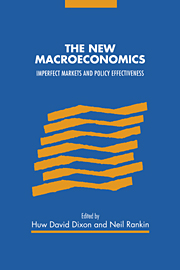Book contents
- Frontmatter
- Contents
- List of contributors
- Preface
- Acknowledgements
- Introduction
- Part I Overviews and perspectives
- Part II Goods market imperfections
- 4 Optimal labour contracts and imperfect competition: a framework for analysis
- 5 Market power, coordination failures and endogenous fluctuations
- 6 Macroeconomic externalities
- Part III Labour market imperfections
- Part IV Financial market imperfections
- Part V Nominal rigidities and bounded rationality
- Bibliography
- Index of authors
- Index of subjects
4 - Optimal labour contracts and imperfect competition: a framework for analysis
Published online by Cambridge University Press: 13 October 2009
- Frontmatter
- Contents
- List of contributors
- Preface
- Acknowledgements
- Introduction
- Part I Overviews and perspectives
- Part II Goods market imperfections
- 4 Optimal labour contracts and imperfect competition: a framework for analysis
- 5 Market power, coordination failures and endogenous fluctuations
- 6 Macroeconomic externalities
- Part III Labour market imperfections
- Part IV Financial market imperfections
- Part V Nominal rigidities and bounded rationality
- Bibliography
- Index of authors
- Index of subjects
Summary
Introduction
This chapter investigates the importance of labour market relations to the macroeconomic inefficiencies associated with imperfectly competitive product markets. Hart (1982) argues that models of imperfect competition are capable of generating macroeconomic results such as an underemployment equilibrium, multiplier effects and so forth. Related results on coordination failures, i.e. the existence of Pareto ordered Nash equilibria, for this class of models are reported by Heller (1986), Kiyotaki (1988), Roberts (1987, 1988) and Cooper (1987).
Some, but not all, of the studies on the macroeconomic implications of imperfectly competitive product markets appear to rest on employment relations between firms and workers which are privately suboptimal. For example, Hart (1982) stresses the importance of market power by the suppliers of labour in his study of imperfectly competitive economies. The ‘contracts’ between workers and firms in Hart's model are not privately optimal in that the allocation does not lie on a contract curve between the contractants.
Another example of this point arises in Weitzman's (1983, 1985) studies advocating share contracts. Weitzman supposes that a ‘wage system’, in which the wage is predetermined and employment is demand determined, exists for the trading of labour services. He then contrasts the welfare properties of this system with alternative compensation schemes assuming that product markets are imperfectly competitive. Cooper (1988a) shows that an imperfectly competitive economy with this structure of labour contracts will generate underemployment equilibria and multiplier effects using a model similar to that of Hart (1982).
- Type
- Chapter
- Information
- The New MacroeconomicsImperfect Markets and Policy Effectiveness, pp. 81 - 93Publisher: Cambridge University PressPrint publication year: 1995



